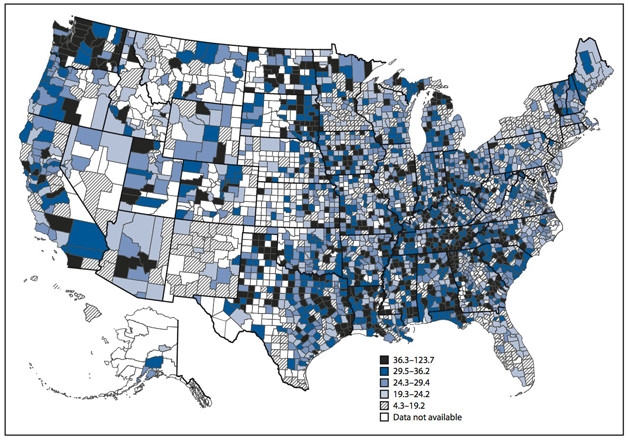Alzheimer’s Deaths on the Rise
Quick Links
In the United States, deaths due to Alzheimer’s disease rose 55 percent between 1999 and 2014, according to results appearing May 26 in the Centers for Disease Control and Prevention Morbidity and Mortality Weekly Report. Scientists led by Christopher Taylor, CDC, used data from death certificates across the United States. They found that the death rate increased over those 15 years, though it’s unclear whether the rate truly rose or AD is simply more likely to be recorded on death certificates. It is probably a mix of factors, the authors wrote. A growing proportion of people died at home rather than in nursing care, suggesting a greater need for services geared to family and friends serving as caregivers.

AD Deaths: This map depicts the average annual death rates (per 100,000 people) for U.S. counties between the years of 2005-2014.
The authors drew from the CDC’s WONDER system, which compiles data on the underlying cause of death listed on death certificates from all 50 states and the District of Columbia. The authors queried deaths attributed to Alzheimer’s—but not other forms of dementia—along with information on a person’s sex, age, race, and whether they were living at home, in a nursing home, in a hospice facility, or being treated at a hospital when they died. To calculate mortality rates, the authors used population data from the U.S. Census Bureau.
From 1999 to 2014, the number of people aged 75 to 84 who died annually from AD rose from 129.5 to 185.6 for every 100,000 people in that age group. In those 85 and older, rates jumped from 601.3 to 1,006.8 per 100,000 people. Considering the entire population, the authors found that the age-adjusted AD death rate per 100,000 people grew from 16.5 in 1999 to 25.4 in 2014. That’s a jump of about 55 percent. In 2014, the rate was higher for women than men, and for whites than for other racial or ethnic groups. Urban and rural areas had higher AD death rates than did large metropolitan areas. Counties in the Southeast, Midwest, and West reported some of the highest rates (see image above).
The authors also noted a shift in patients’ living situations at the time of death. Whereas 68 percent died in a nursing home or long-term care facility in 1999, that number dropped to 54 percent in 2014. Twenty-five percent died at home in 2014 versus 14 percent in 1999. The data suggests family and friends are caring for more patients at home now than ever before, hinting at a need for more education, respite care, and case management aimed at caregivers, Taylor said.
A number of factors likely contribute to the overall increase in reported deaths from AD. First, the U.S. has a growing population of older adults who are living longer. As deaths fall from other causes such as cardiovascular disease and stroke because of better lifestyles and prevention, more people live into old age and die from AD instead. A growing number of people are exceeding 90, 95, and 100 years old, said Eric Larson, Kaiser Permanente Washington Health Research Institute, Seattle. At the same time physicians and coroners have become cognizant of AD and are more likely to recognize and note it on death certificates, the authors wrote. Part of the increase undoubtedly reflects shifts in medical coding, agreed Larson. Codes on death certificates reflect the initiating condition that led ultimately to death.
Even so, this analysis likely underestimates the total number of AD deaths in the U.S., the authors wrote, because it does not capture people who had Alzheimer’s but were deemed to have a different underlying cause of death. It also fails to take into account those with other forms of dementia.
“This is a dramatic increase and draws attention to the burden of care that families and institutions must provide to increasingly more persons with AD,” Larson wrote to Alzforum. “Most people who die with AD require high levels of care for long periods of time. This report points to the need to discover ways to prevent or delay onset and find better ways to care for people who are afflicted with AD.”—Gwyneth Dickey Zakaib
References
No Available References
Further Reading
Papers
- Zeng Y, Feng Q, Hesketh T, Christensen K, Vaupel JW. Survival, disabilities in activities of daily living, and physical and cognitive functioning among the oldest-old in China: a cohort study. Lancet. 2017 Apr 22;389(10079):1619-1629. Epub 2017 Mar 10 PubMed.
News
- Bucking Recent Trend, Netherlands Reports Rising Dementia Incidence
- Dementia Risk Ticks Up Near Major Roadways
- No, Being Thin Does Not Lead to Alzheimer’s Disease
- Put Down That Pop: Sweet Drinks Tied to Stroke, Dementia
- U.S. Dementia Rates Fall
- Global Rise in Total AD Cases Dwarfs Falling Age-Standardized Rate
Primary Papers
- Taylor CA, Greenlund SF, McGuire LC, Lu H, Croft JB. Deaths from Alzheimer's Disease - United States, 1999-2014. MMWR Morb Mortal Wkly Rep. 2017 May 26;66(20):521-526. PubMed.
Annotate
To make an annotation you must Login or Register.

Comments
No Available Comments
Make a Comment
To make a comment you must login or register.